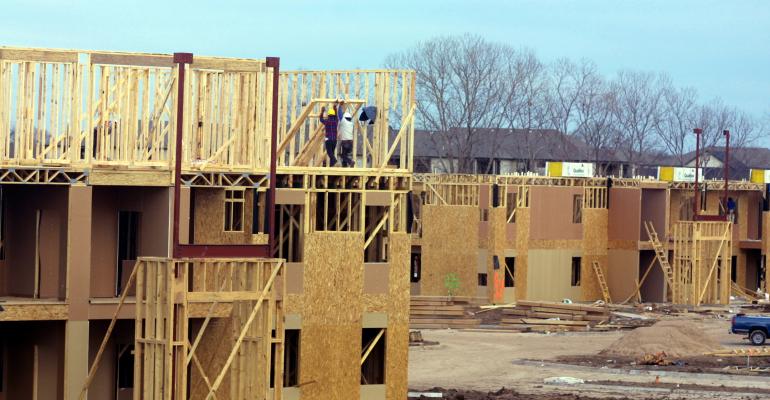A rejuvenated U.S. housing market will help keep the economy chugging along despite the threat posed by a derailment in corporate spending.
Home construction outlays, which account for almost 4% of gross domestic product, increased for a fifth straight month in November, marking a welcome departure from a yearlong slowdown. Buyers, their confidence bolstered by sustained job and income growth, have taken advantage of the lowest borrowing costs in almost three years as Federal Reserve policy makers reduced their benchmark rate three times in 2019.
Stick-Built Strength
The Atlanta Fed’s latest GDPNow estimate has residential investment penciled in at an annualized 3.9% gain for the fourth quarter after growing at a 4.6% pace in the previous three-month period. That would mark the best consecutive quarters of growth since 2016-2017.
Fresh earnings announcements show order books are growing at builders including Lennar Corp., with its increasing focus on the entry-level home segment, and KB Home, which targets first-time buyers. While Lennar shares gained in the wake of its earnings report, KB Home retreated because of closing delays in the fire-stricken Bay Area even with solid orders.
“The indicators that we see and hear from our customers reflect confidence in the stability of the economy and in the job market,” Stuart Miller, Lennar’s chairman, said on the company’s earnings call last week.
While home construction represents almost 4% of the economy, less than nonresidential investment in equipment (5.7%) and structures (2.9%) combined, a further strengthening will help limit the negative effects of capital-spending weakness. What’s more, stronger home sales have the potential of propelling purchases of furnishings and durable household equipment.
Key Reversal
Housing also contributes to growth through consumption of housing and utilities services, which accounts for 12.5% of GDP and includes an estimate of how much it would cost to rent owner-occupied units.
The likely boost to fourth-quarter GDP from residential construction has been accompanied by a flurry of permit applications to build that includes both single-family dwellings and multifamily structures such as apartment buildings. The gains in residential permits show the recent improvement in home starts will probably extend into early 2020.
Unemployment at a five-decade low is gradually driving wage gains, while the bull market in stocks has propelled indexes to record highs and fueled income growth. After the 2018 housing slowdown helped cool price appreciation, the pickup in incomes is giving more Americans the wherewithal to buy a home.
“From a macro perspective, mortgage interest rates remained low, continuing to support favorable market conditions, characterized by steady economic expansion, solid job growth, high consumer confidence and positive demographic trends,” KB Home CEO Jeffrey Mezger said on the builder’s Jan. 9 earnings call. “While these factors fueled strong demand, supply continues to be insufficient to meet homebuyers’ needs.”
Lean inventory at the home resale level is affording builders an opportunity to step up construction as orders pick up. Should recent indications of stabilization in global manufacturing develop into an actual strengthening in factory output, there’s potential for faster economic growth just as the housing market gains more traction.
“While 2019 is in the books, 2020 seems even brighter to us,” Lennar’s Miller said. “We remain encouraged by both market conditions for the remainder of the year and Lennar’s position in it.”
To contact the reporter on this story: Vince Golle in Washington at [email protected].
To contact the editors responsible for this story: Scott Lanman at [email protected]
Anita Sharpe
© 2020 Bloomberg L.P.





